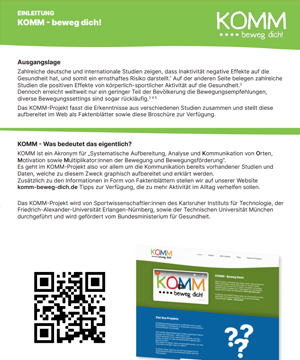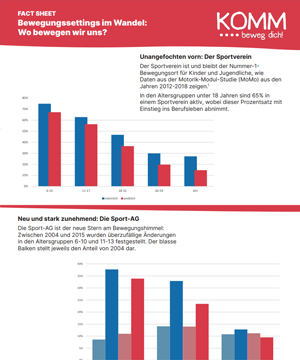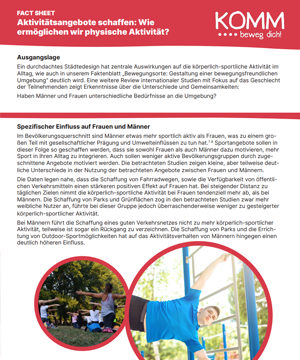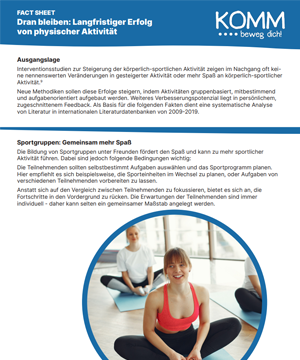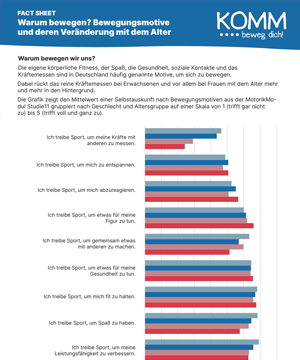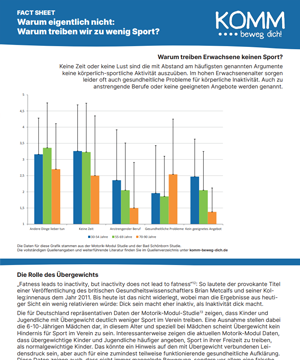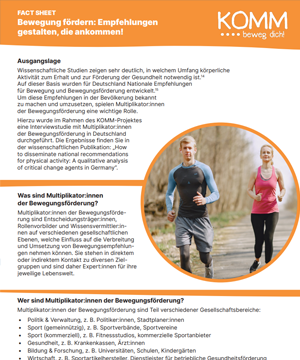Factsheets
Das KOMM-Projekt stellt die gewonnen und gesammelten Erkenntnisse aus der Freizeit- und Bewegungsforschung aufbereitet als Factsheets zur Verfügung.
Um ein Factsheet zu lesen oder herunterzuladen, klicken sie einfach unten auf ein Thema.
Quellen und Bildnachweise
- KOMM - beweg dich!
-
Quellen
1 González, K., Fuentes, J., & Márquez, J. L. (2017). Physical inactivity, sedentary behavior and chronic diseases. Korean journal of family medicine, 38(3), 111.
2 Reiner M, Niermann C, Jekauc D, Woll A. Long-term health benefits of physical activity: a systematic review of longitudinal studies. BMC Public Health 2013; 13(1):813.
3 Suggested citation. WHO guidelines on physical activity and sedentary behaviour. Geneva: World Health Organization; 2020. Licence: CC BY-NC-SA 3.0 IGO
4 Schmidt, S.C.E; Anedda, B., Burchartz, A., Oriwol, D., Kolb, S., Wäsche, H., Niessner, C., Woll, A. (2020). The physical activity of children and adolescents in Germany 2003-2017: The
MoMo-study. PLoS one, 15(7), e0236117.
5 Rütten A, Pfeifer K (Hg). Nationale Empfehlungen für Bewegung und Bewegungs-förderung. Erlangen: FAU Erlangen-Nürnberg; 2016. - Bewegungssettings
-
Quellen
6 Woll, A., Albrecht, C., & Worth, A. (2017). Motorik-Module (MoMo) – the KiGGS Wave 2 module to survey motor performance and physical activity. Journal of Health Monitoring, 2(S3),63-70. https://doi.org/10.17886/RKI-GBE-2017-110
Datenangaben zu den Fakten:
A: Motorik-Modul Studie (MoMo): Schmidt, S.C.E; Anedda, B., Burchartz, A., Oriwol, D., Kolb, S., Wäsche, H., Niessner, C., Woll, A. (2020). The physical activity of children and adolescents in Germany 2003-2017: The MoMo-study. PLoS one, 15(7), e0236117.
B: Bad Schönborn-Studie (BSB): Woll, A. & Schmidt, S. (2018). 25 Jahre Langzeitstudie - Gesundheit zum Mitmachen. Bewegungstherapie und Gesundheitssport, 34: 145–148.
Schmidt, S., Tittlbach, S., Bös, K. & Woll, A. (2017). Different Types of Physical Activity and Health in Adults: An 18-Year Longitudinal Study. BioMed Research International. doi.
org/10.1155/2017/1785217C: Zusätzliche Sonderauswertungen im Rahmen des KOMM-Projektes aus beiden Studiendatensätzen.
Datenhalter: Karlsruher Institut für Technologie und Pädagogische Hochschule Karlsruhe IBS
Aktualität: MoMo: 4-17 Jährige: Daten von 2014-2017 | BSB: Ø 49-Jahre (±10 Jahre): Daten von 2015
Regionalität: MoMo: repräsentative Daten für 4-17-Jährige in Deutschland | BSB: lokale Daten
Verantwortlicher Autor/in für das Faktenblatt: Steffen Schmidt und Claudia NiessnerHinweise für vertiefende Literatur:
Demetriou, Y., Reimers, A. K., Hebestreit, A., Schlund, A., Niessner, C., Schmidt, S., Finger, J., Mutz, M., Völker, K., Vogt, L., Woll, A., & Bucksch, J. (2019). Germany’s 2018 Report Card on
Physical Activity for Children and Adolescents. German Journal of Exercise and Sport Research, 49(2), 113. doi:10.1007/s12662-019-00578-1.
Tittlbach, S. A., Jekauc, D., Schmidt, S. C., Woll, A., & Bös, K. (2017). The relationship between physical activity, fitness, physical complaints and BMI in German adults – results of a longitudinal study. European journal of sport science, 17(8), 1090-1099.Weiterführende Links:
https://www.gesundheit-zum-mitmachen.de
https://www.sport.kit.edu/MoMo - Aktivitätsangebote
-
Quellen
7 Krug, S., Jordan, S., Mensink, G. B., Müters, S., Finger, J., & Lampert, T. (2013). Körperliche Aktivität. Bundesgesundheitsblatt-Gesundheitsforschung-Gesundheitsschutz, 56(5-6),
765-771.
8 Tcymbal, A., Demetriou, Y., Kelso, A., Wolbring, L., Wunsch, K., Wäsche, H., … & Reimers, A. K. (2020). Effects of the built environment on physical activity: a systematic review of longitudinal studies taking sex/gender into account. Environmental Health and Preventive Medicine, 25(1), 1-25.Datenquelle/ Publikation
Tcymbal, A., Demetriou, Y., Kelso, A., Wolbring, L., Wunsch, K., Wäsche, H., Alexander Woll & Reimers, A. K. (2020). Effects of the built environment on physical activity: a systematic
review of longitudinal studies taking sex/gender into account. Environmental Health and Preventive Medicine, 25(1), 1-25.Datenhalter: -
Aktualität: Systematische Literaturrecherche in internationalen Datenbanken 2000-2019 | Altersrange der Zielgruppe: keine bestimme Altersgruppe
Regionalität: Recherche weltweit, internationale Datenbanken
Verantwortliche/r Autor/in für das Faktenblatt: Yolanda Demetriou, Hagen Wäsche, Kathrin Wunsch, Alexander Woll, Anne ReimersHinweise für vertiefende Literatur:
Kärmeniemi M, Lankila T, Ikäheimo T, Koivumaa-Honkanen H, Korpelainen R. The built environment as a determinant of physical activity: a systematic review of Longitudinal Studies and Natural Experiments. Ann Behav Med. 2018;52(3):239-251. Epub 2018/03/15. doi: https://doi.org/10.1093/abm/kax043. PubMed PMID: 29538664.Bildnachweise
https://www.pexels.com/de-de/foto/geparkte-rote-und-weisse-fahrrader-674735/
https://www.canstockphoto.com/muscular-man-doing-human-flag-exercise-37446265.html (lizensierte Nutzung)
- Dran bleiben!
-
Quellen
9 Plotnikoff, R.C.; Costigan, S.A.; Williams, R.L.; Hutchesson, M.J.; Kennedy, S.G.; Robards, S.L.; Allen, J.; Collins, C.E.; Callister, R.; Germov, J. Effectiveness of interventions targeting
physical activity, nutrition and healthy weight for university and college students: A systematic review and meta-analysis. Int. J. Behav. Nutr. Phys. Act. 2015, 12, 45
10 Luszczynska, A., & Schwarzer, R. (2005). Social cognitive theory. Predicting health behaviour, 2, 127-169.Datenquelle/ Publikation:
Klos, L., Feil, K., Eberhardt, T., & Jekauc, D. (2020). Interventions to Promote Positive Affect and Physical Activity in Children, Adolescents and Young Adults—A Systematic Review.
Sports, 8(2), 26.Datenhalter: -
Aktualität: Systematische Literaturrecherche in internationalen Datenbanken 2009-2019 | Altersrange der Zielgruppe 4-23 Jahre
Regionalität: Recherche weltweit, internationale Datenbanken
Verantwortliche/r Autor/in für das Faktenblatt: Leon Klos und Darko JekaucHinweise für vertiefende Literatur:
Jekauc, D.; Brand, R. Editorial: How do Emotions and Feelings Regulate Physical Activity? Front. Psychol. 2017, 8, 1145.Bildnachweise
https://www.pexels.com/de-de/foto/gesund-frau-sitzung-club-3984338/
https://www.pexels.com/de-de/foto/gesund-frau-smartphone-surfen-4428991/
- Warum bewegen?
-
Quellen:
11 Woll, A., Albrecht, C., & Worth, A. (2017). Motorik-Module (MoMo) – the KiGGS Wave 2 module to survey motor performance and physical activity. Journal of Health Monitoring, 2(S3), 63-70. https://doi.org/10.17886/RKI-GBE-2017-110
12 Metcalf, B. S., Hosking, J., Jeffery, A. N., Voss, L. D., Henley, W., & Wilkin, T. J. (2011). Fatness leads to inactivity, but inactivity does not lead to fatness: a longitudinal study in children (EarlyBird 45). Archives of disease in childhood, 96(10), 942-947.
13 Woll, A., Albrecht, C., & Worth, A. (2017). Motorik-Module (MoMo) – the KiGGS Wave 2 module to survey motor performance and physical activity. Journal of Health Monitoring, 2(S3), 63-70. https://doi.org/10.17886/RKI-GBE-2017-110Datenquelle/ Publikation:
A: Motorik-Modul Studie (MoMo): Schmidt, S.C.E; Anedda, B., Burchartz, A., Oriwol, D., Kolb, S., Wäsche, H., Niessner, C., Woll, A. (2020). The physical activity of children and adolescents in Germany 2003-2017: The MoMo-study. PLoS one, 15(7), e0236117.
B: Bad Schönborn-Studie (BSB): Woll, A. & Schmidt, S. (2018). 25 Jahre Langzeitstudie - Gesundheit zum Mitmachen. Bewegungstherapie und Gesundheitssport, 34: 145–148.
Schmidt, S., Tittlbach, S., Bös, K. & Woll, A. (2017). Different Types of Physical Activity and Health in Adults: An 18-Year Longitudinal Study. BioMed Research International. doi.org/10.1155/2017/1785217C: Zusätzliche Sonderauswertungen im Rahmen des KOMM-Projektes aus beiden Studiendatensätzen.
Datenhalter: Karlsruher Institut für Technologie IfSS und Pädagogische Hochschule Karlsruhe IBS
Aktualität: MoMo: 4-17-Jährige: Daten von 2014-2017 | BSB: Ø 49-Jahre (±10 Jahre): Daten von 2015
Regionalität: MoMo: repräsentative Daten für 4-17-Jährige in Deutschland | BSB: lokale Daten
Verantwortliche/r Autor/in für das Faktenblatt: Steffen Schmidt und Claudia NiessnerHinweise für vertiefende Literatur:
Huffman, M. K., Reed, J. B., Carpenter, T., & Amireault, S. (2020). Maintenance motives for physical activity among older adults: a protocol for a systematic review and meta-analysis.
BMJ open, 10(2).Król-Zielińska, M., Groffik, D., Bronikowski, M., Kantanista, A., Laudańska-Krzemińska, I., Bronikowska, M., … & Frömel, K. (2018). Understanding the motives of undertaking physical
activity with different levels of intensity among adolescents: Results of the INDARES Study. BioMed research international, 2018. - Warum nicht?
-
Quellen:
11 Woll, A., Albrecht, C., & Worth, A. (2017). Motorik-Module (MoMo) – the KiGGS Wave 2 module to survey motor performance and physical activity. Journal of Health Monitoring, 2(S3), 63-70. https://doi.org/10.17886/RKI-GBE-2017-110
12 Metcalf, B. S., Hosking, J., Jeffery, A. N., Voss, L. D., Henley, W., & Wilkin, T. J. (2011). Fatness leads to inactivity, but inactivity does not lead to fatness: a longitudinal study in children (EarlyBird 45). Archives of disease in childhood, 96(10), 942-947.
13 Woll, A., Albrecht, C., & Worth, A. (2017). Motorik-Module (MoMo) – the KiGGS Wave 2 module to survey motor performance and physical activity. Journal of Health Monitoring, 2(S3), 63-70. https://doi.org/10.17886/RKI-GBE-2017-110Datenquelle/ Publikation:
A: Motorik-Modul Studie (MoMo): Schmidt, S.C.E; Anedda, B., Burchartz, A., Oriwol, D., Kolb, S., Wäsche, H., Niessner, C., Woll, A. (2020). The physical activity of children and adolescents in Germany 2003-2017: The MoMo-study. PLoS one, 15(7), e0236117.
B: Bad Schönborn-Studie (BSB): Woll, A. & Schmidt, S. (2018). 25 Jahre Langzeitstudie - Gesundheit zum Mitmachen. Bewegungstherapie und Gesundheitssport, 34: 145–148.
Schmidt, S., Tittlbach, S., Bös, K. & Woll, A. (2017). Different Types of Physical Activity and Health in Adults: An 18-Year Longitudinal Study. BioMed Research International. doi.org/10.1155/2017/1785217C: Zusätzliche Sonderauswertungen im Rahmen des KOMM-Projektes aus beiden Studiendatensätzen.
Datenhalter: Karlsruher Institut für Technologie IfSS und Pädagogische Hochschule Karlsruhe IBS
Aktualität: MoMo: 4-17-Jährige: Daten von 2014-2017 | BSB: Ø 49-Jahre (±10 Jahre): Daten von 2015
Regionalität: MoMo: repräsentative Daten für 4-17-Jährige in Deutschland | BSB: lokale Daten
Verantwortliche/r Autor/in für das Faktenblatt: Steffen Schmidt und Claudia NiessnerHinweise für vertiefende Literatur:
Huffman, M. K., Reed, J. B., Carpenter, T., & Amireault, S. (2020). Maintenance motives for physical activity among older adults: a protocol for a systematic review and meta-analysis.
BMJ open, 10(2).Król-Zielińska, M., Groffik, D., Bronikowski, M., Kantanista, A., Laudańska-Krzemińska, I., Bronikowska, M., … & Frömel, K. (2018). Understanding the motives of undertaking physical
activity with different levels of intensity among adolescents: Results of the INDARES Study. BioMed research international, 2018. - Bewegung fördern!
-
Quellen
14 Reiner M, Niermann C, Jekauc D, Woll A. Long-term health benefits of physical activity: a systematic review of longitudinal studies. BMC Public Health 2013; 13(1):813.
15 Rütten A, Pfeifer K (Hg). Nationale Empfehlungen für Bewegung und Bewegungs-förderung. Erlangen: FAU Erlangen-Nürnberg; 2016.Datenquelle/ Publikation:
Wolbring, L., Reimers, A. K., Niessner, C., Demetriou, Y., Schmidt, S., Woll, A. & Wäsche, H. (in prep.). How to disseminate national recommendations for physical activity: A qualitative analysis of critical change agents in Germany.
Datenhalter: -
Aktualität: Interview Studie im Oktober 2019 bis April 2020
Regionalität: Die Auswahl der Experten erfolgte auf Basis der in der SAMBA-Studie identifizierten Multiplikator:innen der Bewegungsförderung in Deutschland
Verantwortliche/r Autor/in für das Faktenblatt: Laura Wolbring, Hagen Wäsche, Claudia Niessner, Anne Reimers, Yolanda Demetriou, Alexander Woll und Steffen SchmidtHinweise für vertiefende Literatur:
Wäsche H, Peters S, Appelles L, Woll A. Bewegungsförderung in Deutschland: Akteure, Strukturen und Netzwerkentwicklung. B & G 2018; 34(06):257–73.Bildnachweise
https://www.pexels.com/de-de/foto/gesund-menschen-park-morgen-4148937/
https://www.pexels.com/de-de/foto/gesund-person-frau-laptop-4498450/
- Multiplikatorennetze
-
Quellen
16 Wäsche, H., Panter, L., Mehl, R. & Rapp, S. (2019). Sport und Bewegung in der Karlsruher Oststadt : Ergebnisbericht. Karlsruher Institut für Technologie (KIT). doi:10.5445/IR/1000089358
Aktualität: Online-Befragung im Mai bis August 2017
Regionalität: Daten auf Ebene der Kommune
Verantwortliche/r Autor/in für das Faktenblatt: Hagen Wäsche und Laura WolbringHinweise für vertiefende Literatur:
Wäsche H, Peters S, Appelles L, Woll A. Bewegungsförderung in Deutschland: Akteure, Strukturen und Netzwerkentwicklung. B & G 2018; 34(06):257–73.Bildnachweise
https://www.pexels.com/de-de/foto/gruppe-von-sportspielern-kniend-auf-dem-feld-262524/
